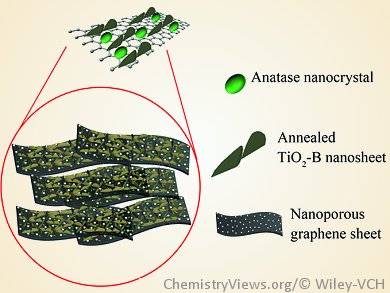Ti-based materials are highly attractive as anode materials for lithium-ion batteries because of their low cost, high stability, and good characteristic safety compared to graphite. Towards this end, Yunhui Huang and his group, Huazhong University of Science and Technology, Wuhan, China, have developed a facile microwave-induced in situ reduction–hydrolysis synthesis approach to fabricate a nanoporous graphene–TiO2 hybrid material.
The resulting nanoporous graphene material co-anchored with ultrafine TiO2–B nanosheets and anatase nanocrystals has a hierarchically porous structure, with both meso- and macropores in the graphene sheets and a large surface area. An electrode made of this material possessed superior rate capability and excellent cyclability.
The team believes that this graphene–TiO2 hybrid material can be extended to other advanced applications in the fields of photocatalysis, sensing, and solar cells and that this new synthetic approach could open the doors to an easy and efficient fabrication of other functionalized nanohybrids.
- TiO2–B Nanosheets/Anatase Nanocrystals Co-anchored on Nanoporous Graphene: In Situ Reduction–Hydrolysis Synthesis and Their Superior Rate Performance as an Anode Material,
C. Chen, X. Hu, Y. Jiang, Z. Yang, P. Hu, Y. Huang,
Chem. Eur. J. 2014.
DOI: 10.1002/chem.201303734



